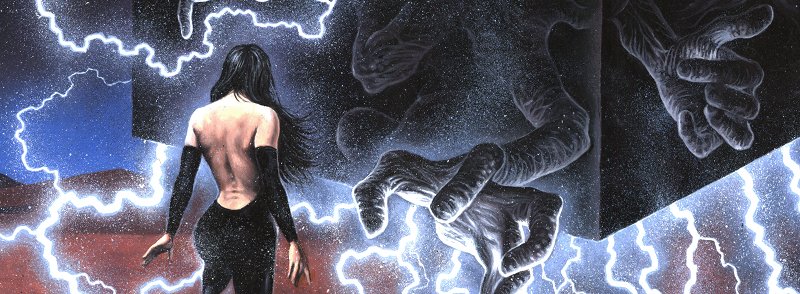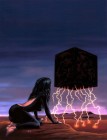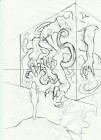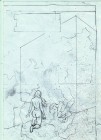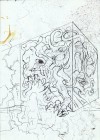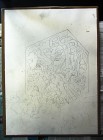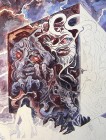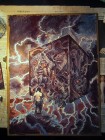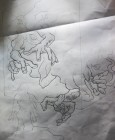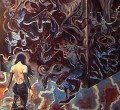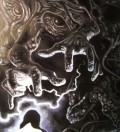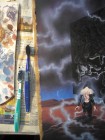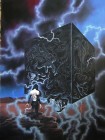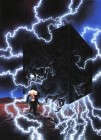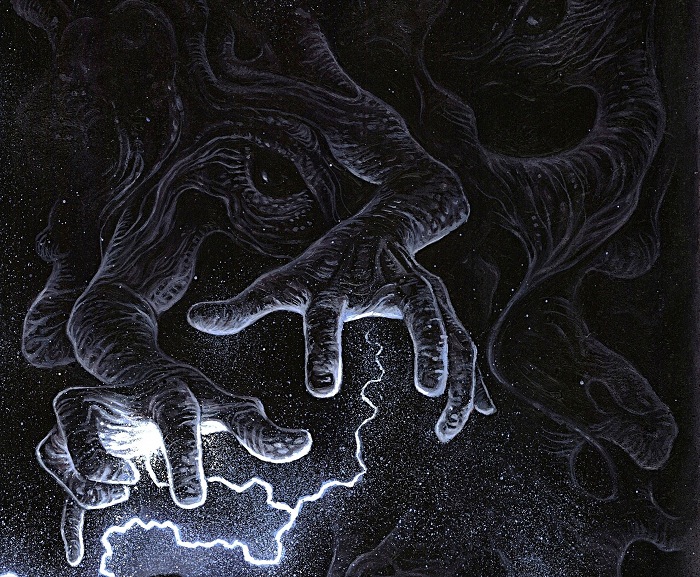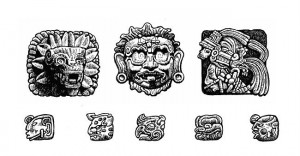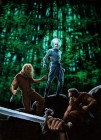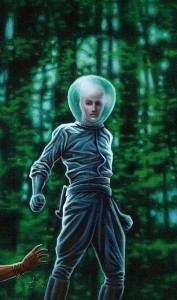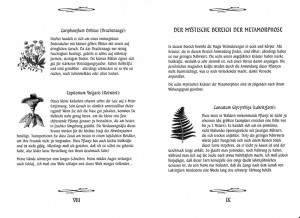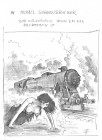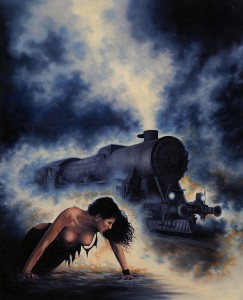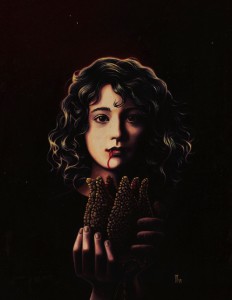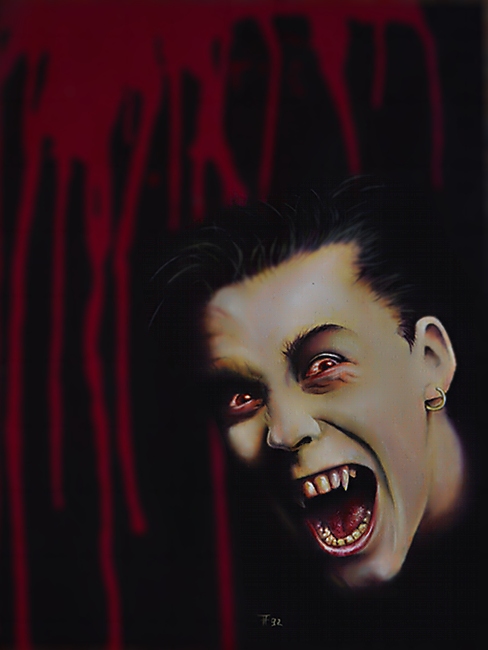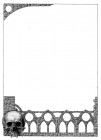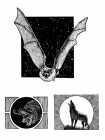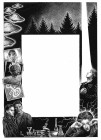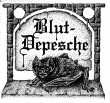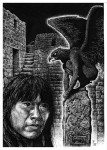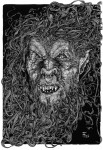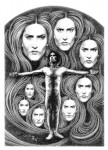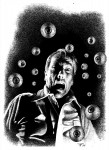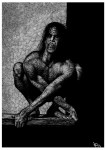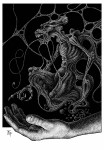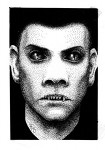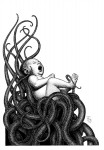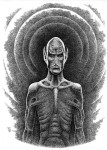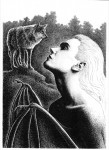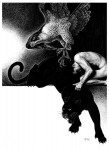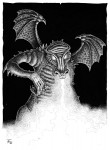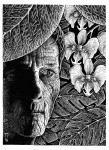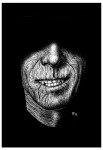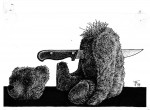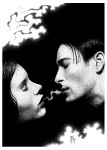Vampira Vol. 13, Traumzeit-Dämonen (Dreamtime Demons) – The Making of a Pulp Cover Illustration
“In diesem Augenblick materialisierte vor ihr etwas, das die Unwirklichkeit verdichtete: Ein gewaltiger über dem roten Sand schwebender Quader, der aussah wie ein Klotz aus tonnenschwerer Dunkelheit! Die ganze Schwärze des Universums schien an diesem einen Punkt zusammengeballt zu sein, in einen Würfel gepresst, dessen Kanten und Konturen geschliffen scharf wirkten.
Lilith stockte der Atem Alle ihre Sinne konzentrierten sich auf diesen Block aus Finsternis, aus dessen Unterteil plötzlich gezackte Blitze in den Wüstenboden stießen und Sandfontänen aufwarfen. Lilith wurde von ein paar der “elektrisch” aufgeladenen Körnern getroffen. Sie prasselten gegen die Hülle des Symbionten, der die Form eines rückenfreien, vorn aber bis zum Hals geschlossenen Catsuits angenommen hatte. (…)
Die äscherne Aura hüllte Lilith erneut ein. Eng anliegend wie eine dritte Haut, wenn man den Symbionten als zweite einstufte. (…) Zentimeter trennten Lilith noch von dem schwebenden Koloss, in dem sich – sie sah es jetzt deutlich – schreckliche, schemenhafte Gestalten tummelten.(…) Und wieder machte sie einen Schritt, den sie gar nicht wollte. Berührte noch nicht selbst, aber mit der äschernen Aura das Domizil der entarteten Wondjinas! (…)
Vor Lilith schnellte etwas aus dem dunklen Vorhang. Etwas, das wie ein narbiger, furunkelübersähter, eiternder Arm aussah, aber keiner sein konnte. Es war nur der Abdruck eines Dings, das dort, woher es auf Lilith zustieß, keine Form besaß. (…) Immer mehr Arme und andere, menschlichen Extremitäten nachempfundene Extremitäten stießen aus em nachtschwarzen Quader.”
From: Adrian Doyle (Manfred Weinland), Traumzeit-Dämonen (Dreamtime Demons) und Apokalypse (Apocalypse), Vampira Bd. 13 und 14, © Bastei
The original cover illustration for volume 13 of the horror pulp series Vampira from 1995 was based on a brief description by the editor: Australian outback, in the foreground the series’ protagonist, dressed in a black, back free catsuit, in the backgound a huge, black, hovering cube, sending flashes of lightning to the red desert below; in its inside shadowy demons.
What I had in my mind when I created the painting back then was a little bit of a mixture between Caspar David Friedrich, Edgar Ende and Kubricks 2001 (the black monoliths), a rather unspectacular, calm scene. The deep blackness of the cube was more important to me than the demons, and because of that I only hinted at them with a few brushstrokes.
I do like some things about the painting, but in general it did not turn out as I imagined, and the figure in the foreground has its weaknesses, too (a really big head, for example). The cube was digitally lightened for print, with the result that neither the monolith was black as it should have been, nor the demons became more recognisable (simply because i did not really paint them).
The new edition of the series in 2011 provided the opportunity to paint the same scene again with quite a different approach – less like a Caspar David Friedrich painting and more dramatic, the flashes of lightning more vivid, the cube much closer to the foreground and really black, but without making the demons disappear in this blackness.
- Erste Skizze
- Vorzeichnung
- Vorzeichnung
- Vorzeichnung, auf Malkarton übertragen
The pencil drawings are DIN A4; the finished drawing was enlarged and transfered to painting cardboard (40 x 55 cm). For the first, rather sketchy colour layer I always use acrylyc, basically to try different colours and to define light and shadow.
- Beginn der Acrylfarben-Untermalung
- Acrylfarben-Untermalung, zur Hälfte fertig
- Arcylfarben-Untermalung, fertig
After I had finished the acrylic layer, I did not like the demons’ claws anymore and changed them to more human looking hands, using my own hands as a reference.
- Referenzfoto für Hand
- Vorzeichnung für Hände
- Neue Zeichnung der Hände auf Malgrund übertragen
- Neue Acryl-Untermalung der Hände
On top of the acrylic paint came two complete layers of oil paint plus additional details. For the “ashlike aura”, as it is described in the novel, and the sparks of light I used toothbrushes. The last step was to paint the whites cores of the lightning flashes.
- Erste Ölfarbenschicht, zu einem Drittel fertig
- Erste Ölfarbenschicht, Detail
- Erste Ölfarbenschicht, fertig
- Zahnbürsten zum Sprenkeln
- Zweite Ölfarbenschicht, Hintergrund fertig
- Blitze
- Fertiges Bild
The pulp novel was published on october 18.
Cover Illustrations for a New Edition of the Pulp Series Vampira, 1994/1995/2011
- Bd. 3
- Bd. 7
- Bd. 13
On may 3, 2011, Bastei started the the relaunched edition of the bi-weekly horror pulp series Vampira. Volume 3 and 7 display reprints of two of my cover images from 1994 and 1995. A brand new cover illustration will follow in october. More about Vampira and more images in the article about the original series from the 90s.
Covers: © Bastei Lübbe
Title Page for the Pulp Series 2012 – Das Jahr der Apokalypse, 2011
- Bleistiftskizze
- Fertige Zeichnung
- Gedruckte Rotaseite
2012 – Das Jahr der Apokalypse (The Year of the Apocalypse) is an adventure/mystery pulp mini-series published by Bastei since September 6, 2011. It deals with the apocalypse allegedly predicted by the Mayan calendar.
To create the ink drawing for the interior title page (The so called “Rota-Seite”) I was given a series synopsis, a list of possible subjects and a few compulsory subjects: the Maya plaque and stele, the Easter Island statue and some Central American pyramids (I chose Uxmal and Chichen Itza). The first sketch was improved according to further suggestions by the editor, Michael Schönenbröcher. The vignettes are used as chapter headers.
More information about the series here
More pulp series title pages here .
Rota-Seite: © Bastei-Lübbe
Cover Illustrations for the Pulp Series Maddrax, 2000
Maddrax is a German pulp series published biweekly by Bastei since 2000. The series is a genre mixture of science-fiction, horror and fantasy and evolves around the former United Air Force pilot Matthew Drax who has been transported some 500 years into a post-apocalyptic future.
In addition to the black-and-white title page, used till vol. 100, I contributed two cover illustrations, according to the editor’s descriptions.
The authors of these two novels are Jo Zybell (vol. 10) and Bernd Frenz (vol. 22).
More on Maddrax in the Maddrax Wiki or in a current Deutschlandfunk post.
Covers: © Bastei Lübbe
Herbal “Chayborianische Kräuter” (Chayborian Herbs), 1995
The booklet with drawings of 30 ficticious herbs were a supplement to the German edition of the fantasy Amiga computer game “Tower of Souls”, published by Black Legend. The game was also supplemented by a novel written by the Bastei editor Michael Schönenbröcher who conveyed the commission.
Cover Illustrations for the Pulp Series Vampira, 1992–98
- Bd. 7
- Bd. 9
- Bd. 20
- Bd. 27
- Bd. 38
- Bd. 38
- Bd. 39
- TH Bd. 9
- TH Bd. 17
- TH Bd. 1
- TH Bd. 18
- TH Bd. 37
- TH Bd. 39
- TH Bd. 47
- TH Bd. 54
- Skizze für Bd. 38
- Skizze für TH Bd. 17
- Skizze für TH Bd. 39
- Skizze für nicht realisiertes Titelbild
- dito
Vampira is a horror pulp fiction series which was published by Bastei between 1994 and 1999. It reached 110 volumes, 50 in the typical German “Heftroman” format and 60 in in the more paperback-like “Taschenheft” format and with new numbering. Vampira was created by the author Manfred Weinland and the Bastei editor Manfred Schönenbröcher. A new edition started on May 3, 2011.
During the 90s I contributed 18 cover illustrations, all of them oil paintings on cardboard, approx. 40 x 50 cm. Almost all of them (except the covers for vol. 9 and 27 which dated prior to the series) were created after brief descriptions by the editor. As the series subtitle “Dangerous – Mysterious – Erotic” suggests, the motto “sex sells” was part of the basic idea, and the covers reflect that idea (not always, though, sometimes they were allowed to be more mysterious than erotic). The most important accessory of the heroine is a shape-shifting dress, whose literal “life of its own” justifies even the most absurd outfit …
The series’ title, “Vampira”, is not the heroine’s name but just a catchy word that summs up what this is all about (and maybe it’s a little hommage to Maila Nurmi). The title doesn’t even appear in the novels. The protagonist’s name is Lilith Eden, a not-too-subtle hint at the series’ mythological, actually biblical, background story that uses Old Testament motives as the fall of men and Noah’s ark as well as bits and pieces from other mythologies quite inventively.
The others authors of the pictured novels (besides Manfred Weinland) are Uwe Voehl (vol. 38), Carter Jackson (Taschenheft vol. 9) and Timothy Stahl (Taschenheft Vol 17, 18, 37, 54).
Overview of the whole Vampira series at gruselromane.de
Cover: © Bastei Lübbe
Title Pages and Other Repeatedly Used Illustrations for Pulp Series , 1994–1999
- Vampira, Rota-Seite
- Vampira, Rota-Seite gedruckt
- Vampira, Vorankündigungsseite
- Vampira, drei Kapitel-Trenner
- Die UFO-Akten, Rota-Seite
- Amerika!, Rota-Seite
- Amerika! Vorankündigungsseite
- Maddrax, Rota-Seite
- Maddrax, Vorankündigungsseite
- Maddrax, drei Kapitel-Trenner
The so called “Rota-Seite” (named after the rotating printing machines) is the third page of a pulp magazine. In some cases it is illustrated with a fitting drawing to frame the teaser. I drew this kind of repeatedly used illustrations for four different pulp series. Maddrax and Vampira are still (or again) running, but have new title pages, Amerika! and Die UFO-Akten (inspired, obviously, by The X-Files) were abandoned after a year.
In 2011 I drew the title page for the series 2012.
Illustrations for the Horror Pulp Series Dämonenland , Part 2, 1994–96
- Bd. 122, Earl Warren, Der Fluch des Inka
- Bd. 124, W.K. Giesa und Manfred Weinland, Aufbruch der Werwölfe
- Bd. 133, Fritz Leiber, Spielball der Hexen
- Bd. 134, Frank Bowman, Satans Erbe
- Bd. 136, Logan Derek, Der Augensammler
- Bd. 137, T.R. Mahn, Das Monster aus der Tiefe
- Bd. 138, R. Warner-Crozetti, Die Kapuzenmänner
- Bd. 139, Hugh Walker, Bestien der Nacht
- Bd. 142, Wolfgang Hohlbein, Das Phantom der U-Bahn
- Bd. 146, Dan Shocker, Schreckensmahl
- Bd. 152, Uwe Voehl, Im Schloss der 1000 Tode
- Bd. 153, James R. Burcette, Der Herr der Untoten
- Bd. 153, James R. Burcette, Der Herr der Untoten
- Bd. 161, James R. Burcette, Die sanften Bestien
- Bd. 164, Das Grauen von Chichen Itza
- Bd. 167, Earl Warren, Der Satansorden von Chalderon
- Bd. 169, Damian Fox, Die Spur des Drachen
- Bd. 169, Damian Fox, Die Spur des Drachen
- Bd. 172, Rebecca LaRoche, Der Dschungeldämon
- Bd. 173, W.K. Giesa und Manfred Weinland, Die Vampir-Klinik
- Bd. 173, W.K. Giesa und Manfred Weinland, Die Vampir-Klinik
- Bd. ?
- Bd. ?
- Bd. 141, Manfred Weinland, Schattenkinder
- Bd. 174, W.K. Giesa und Manfred Weinland, Draculas Rückkehr
From 1991 till 1996 I drew about 160 illustrations for the horror pulp series Dämonenland, published by Bastei (more here). In the beginning I shared the job with Thorsten Krächan, after he had left I did it exclusively. In addition, four oil paintings were used as cover illustrations.
Overview of all Dämonenland booklets at gruselromane.de.

